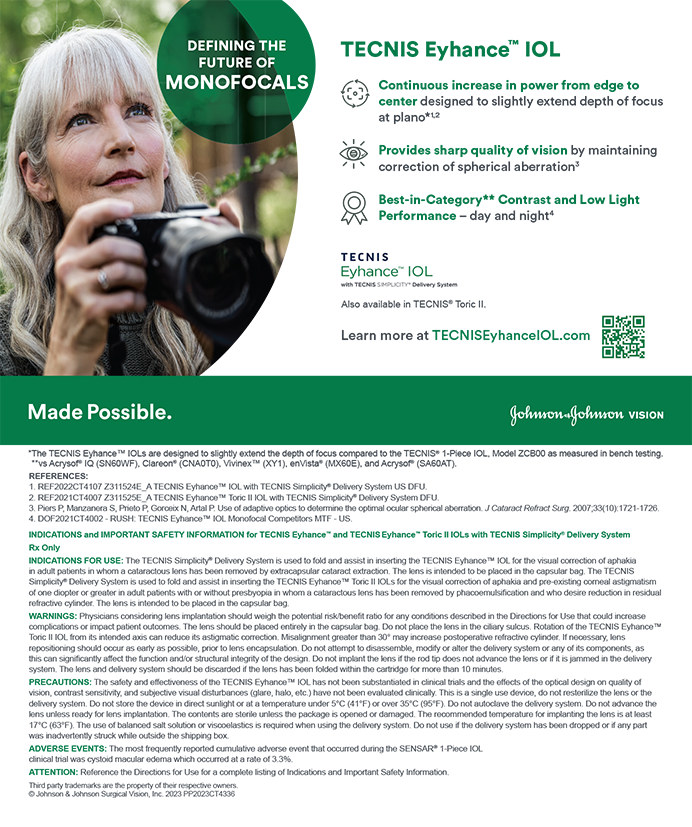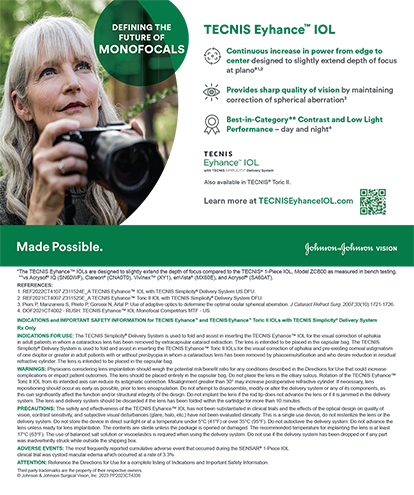Nearly two thirds of the blind people in the world are women! In part, this disparity exists because women live longer than men?typically, by 7 years, according to 2006 data from the World Health Association. In the developed world, this translates into more women than men living with end-stage macular degeneration. In developing countries, however, more older women are blind because of cataracts compared with older men, not only because they live longer, but also because women are less likely to undergo cataract surgery than men. My friend, Suzanne Gilbert, PhD, MPH, has been at the cutting edge of developing systems for eye care delivery for more than 20 years. In this month's column, Dr. Gilbert and her coauthor Ken Bassett, MD, PhD, explore the reasons why fewer women receive cataract surgery and present strategies to overcome this disparity. |
| —Geoffrey Tabin, MD, Section Editor |
Many surgeons in the developing world are unaware that women account for two thirds of the patients blinded by cataracts,1 and very few hospitals in those countries track or report the sex of the patients who seek cataract surgery. In fact, most hospitals lack a program that can educate its ophthalmic staff, managers, and the community at large about gender inequality in eye care. As a consequence, women often fail to get the treatment they need. New research and treatment initiatives, however, are beginning to address the factors that contribute to unnecessary blindness among women.
MEASURING CATARACTS' IMPACT
Developmental or age-related cataracts cause approximately 50 of world blindness.2 The prevalence of cataract-related blindness typically remains low (<1) until approximately the fourth decade of life, when it can affect as many as 5 to 10 of people over the age of 50.2
Women have a slightly higher age-adjusted incidence of cataracts compared with men, but this biological difference (0.1) is small compared to the large overall difference in the prevalence of cataracts between men and women.3
EXPLORING THE BIAS
Worldwide, most of the women who are blind are over the age of 60 and 90 of them live in poverty.4 The disparity in the rates of blindness between women and men is supported by most population-based surveys from western industrialized and economically poorer countries. The gender difference also holds true, albeit for different reasons, for virtually all of the preventable and treatable conditions that cause blindness, including cataracts,1 and infectious diseases such as trachoma.5 Only less treatable ophthalmic conditions such as age-related macular degeneration occur at the same age-adjusted rates between women and men.6-8
Biological differences do not explain the increased prevalence of blindness among women. Instead, women of all ages are more frequently exposed to factors associated with blindness such as infectious diseases and malnutrition, and they utilize eye care services less frequently than men.
Social differences primarily determine the increased prevalence of blindness among women. For example, women are less likely to seek cataract surgery because
- their personal and work-related needs are undervalued; therefore, their visual needs are considered less important than those of men;
- women have less access to familial resources and less control over economic decision making. In poorer families, money is not made available to women for surgery; and
- women who do have surgery are more likely to undergo outdated or less effective procedures compared with men.
ADVOCACY AND IMPACT
In 2002, the Gender and Blindness Network was established to highlight the greater prevalence of blindness among women, coordinate research into women's utilization of cataract surgery, and initiate interventional programs. Participating organizations include the British Columbia Center for Epidemiologic and International Ophthalmology in Vancouver, British Columbia; Seva Foundation and its Center for Innovation in Eye Care; Seva Canada; Kilimanjaro Centre for Community Ophthalmology in Tanzania; Aravind Eye Care System in India; and the Lumbini Eye Institute in Nepal.9 Most recently, the network has expanded to include sites in Uganda and Egypt, primarily through direct-contact network partners. The Boston-based Women's Eye Health Task Force has also joined forces with the Gender and Blindness Network and the International Agency for the Prevention of Blindness to form the Gender Working Group for the VISION 2020: The Right to Sight Initiative.
Programs established in Nepal (Figures 1 and 2), Tanzania (Figure 3), and India have reduced gender inequity through local public health initiatives and by implementing broader community-based services such as water sanitation projects. The program partners in these countries found that women in their reproductive years determine the overall utilization of primary healthcare services, including eye care.10-12 In turn, female literacy (as a surrogate for educational attainment) is the key factor affecting women's utilization of primary healthcare services. Female literacy remains the strongest independent predictor of health service utilization by women themselves and of an overall population, across all socioeconomic levels. Examples from Southern India repeatedly show that indirectly investing in female literacy improves all aspects of public health through the increased use of already available health services, without any additional investment in health services themselves.11
SUMMARY
Eye care services, indeed most health services, are inadequate for men and women outside industrialized countries, but women face particular barriers that keep them from getting treatment, even when it is available. Although the Gender and Blindness Network strives to improve overall access to eye care services, it seeks to achieve this goal through gender-specific versus gender-neutral interventions.
The authors would like to dedicate this article to the life's work of the late Govindappa Venkataswamy, MD, Founder and Chairman of the Aravind Eye Care System, Madurai, India, as well as Founding Board Member of the Seva Foundation. The efforts of "Dr. V's" team inspired people at hundreds of eye hospitals around the world to provide accessible, sustainable, quality services that blind people could not afford otherwise. His quest to reach the entire community catalyzed the early study of the barriers that prevented poor people's access to free cataract surgery.
Suzanne S. Gilbert, PhD, MPH, is Director of the Center for Innovation in Eye Care at the Seva Foundation in Berkeley, California. Dr. Gilbert may be reached at (510) 845-7382 ext. 314; Suzgilbert@earthlink.net.
Ken Bassett, MD, PhD, is Director of the BC Centre for Epidemiology and International Ophthalmology at the University of British Columbia, Vancouver, Canada. He is also Senior Medical Consultant at the University's Centre for Health Services and Policy Research. Dr. Bassett may reached at (604) 822-3130; bassett@chspr.ubc.ca.


